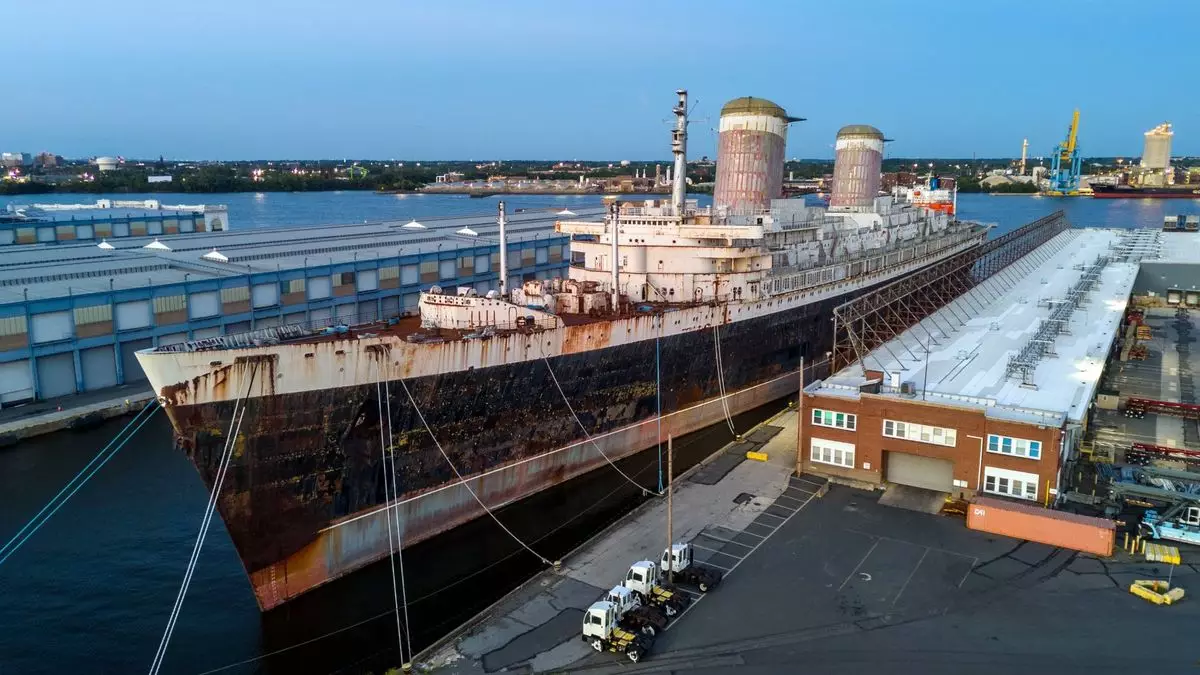The SS United States, often affectionately referred to as “the Big U,” has a legacy that resonates deeply within maritime history. Launched in 1952, the ocean liner was a marvel of engineering and design, synonymous with speed and luxury. It dominated the transatlantic route until its retirement in 1969, boasting a record that has yet to be surpassed: it holds the Blue Riband for the fastest transatlantic crossing, completing the journey from New York to Cornwall in an astounding three days and 10 hours, reaching speeds of approximately 44 knots. This vessel represented the pinnacle of cool, mid-20th-century travel during a time when ocean crossings were both an adventure and a status symbol, connecting continents and cultures.
Yet, while the grandeur of the SS United States has become a cherished memory, its present is overshadowed by uncertainty. After decades of inactivity, during which the ship has languished at a Philadelphia dock, plans are emerging for its fate. On October 1, 2023, the Board of County Commissioners in Okaloosa County backed an initiative to acquire the vessel for the ambitious purpose of converting it into the world’s largest artificial reef off the coast of Florida.
The proposal put forth by Destin-Fort Walton Beach and the SS United States Conservancy offers a new chapter for this storied ship, coupled with a bittersweet sense of finality. By transforming the Big U into an artificial reef, the initiative aims to leverage the vessel’s historical significance while providing ecological benefits. The plan emphasizes not only the environmental advantages of creating an underwater habitat for marine life but also includes potential funding for a museum dedicated to the vessel’s rich history and legacy. This blend of remembrance and ecological stewardship may resonate with both locals and tourists, enhancing the area’s appeal as a diving and fishing destination.
Despite its historical relevance, the transition to a reef brings with it various complexities. The conservancy is entwined in a decade-long struggle to repurpose the ship in a way that honors its past. While there was once hope for its restoration as a luxury cruise liner, repeated attempts to revive the vessel for active service have faltered under financial and logistical pressures. Norwegian Cruise Line’s dreams of refurbishment in the early 2000s and Crystal Cruises’ plans to revamp the liner into a modern passenger ship highlight the challenges that come with preserving maritime heritage in a rapidly evolving industry.
The view to convert the SS United States into an artificial reef is a complex decision, intertwining elements of nostalgia, economic prospects, and environmental consciousness. As Jennifer Adams, the tourism director of Destin-Fort Walton Beach, articulated, the project promises to enrich local marine ecosystems while simultaneously catering to the tourism economy. However, questions about the logistics of cleaning, transporting, and ultimately sinking such a vast vessel — all estimated to cost approximately $10.1 million — remain pressing concerns.
In an age where sustainability is paramount, the transformation also embraces a critical environmental mission. Artificial reefs play a key role in marine conservation by providing habitats for fish and other marine life, fostering biodiversity in areas otherwise bereft of natural reefs. This initiative represents a unique opportunity: it not only seeks to preserve a historic ship from the potentially devastating fate of scrapping, but also to harness its immense form to bolster environmental efforts.
As the conservancy continues its negotiations, the anticipated timeline for this transition includes an intricate mediation process and eventual transportation efforts that could span up to a year and a half. What unfolds now is a meticulous balancing act between historical preservation and practical concerns about marine ecology.
As the SS United States stands on the precipice of its final phase, it evokes poignant reflections on maritime legacy. While its days of majestic transatlantic voyages are long gone, the potential reclamation of its identity as an artificial reef symbolizes not just an end, but a metamorphosis that aligns with modern values of sustainability and conservation. The idea of giving the Big U a second life emphasizes the need to repurpose legacy structures for contemporary benefit, ultimately creating new pathways for engagement with maritime history.
Whether viewed through the lens of nostalgia for a bygone era or anticipation for ecological revitalization, the journey of the SS United States underscores the importance of fostering a harmonious relationship between history and progress. The story of the Big U is far from over; it may yet transcend its physical form, continuing to inspire generations to come as both a symbol of human ingenuity and a guardian of marine life.


Leave a Reply